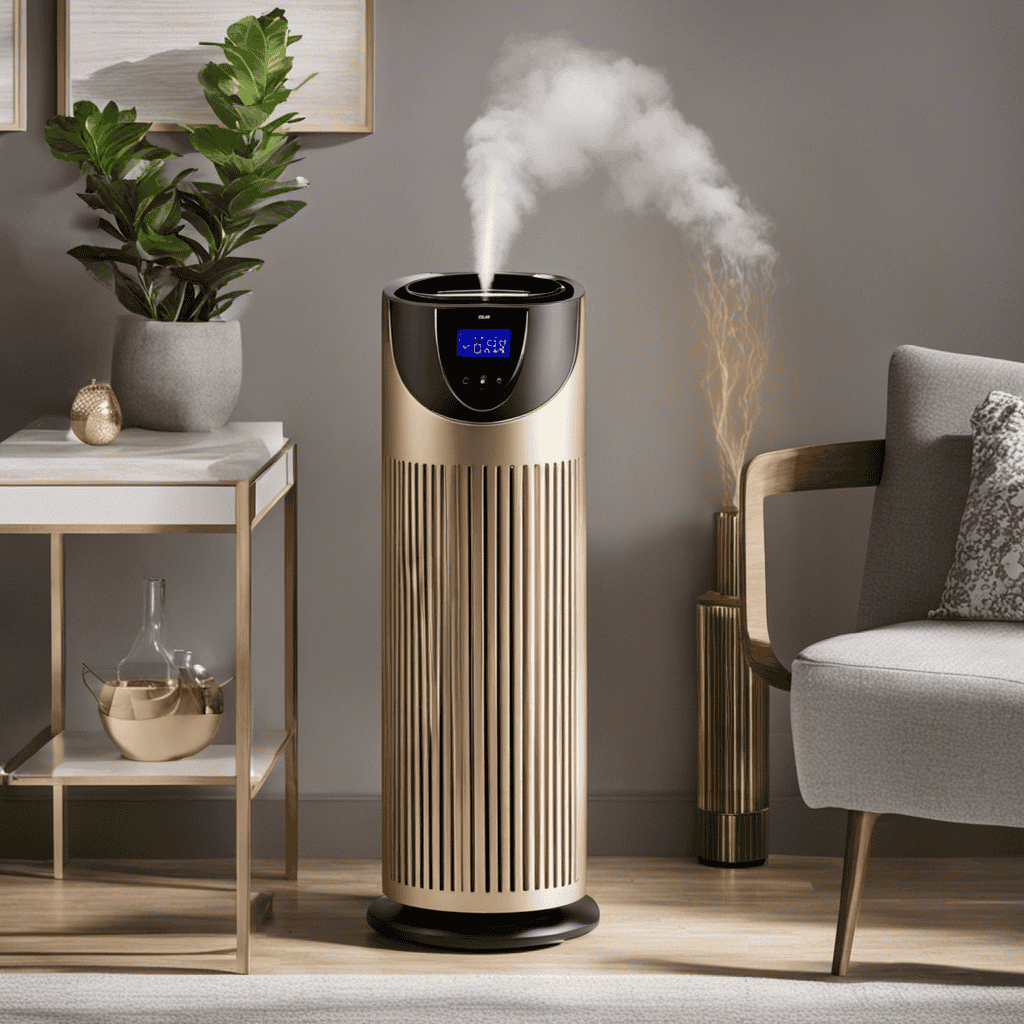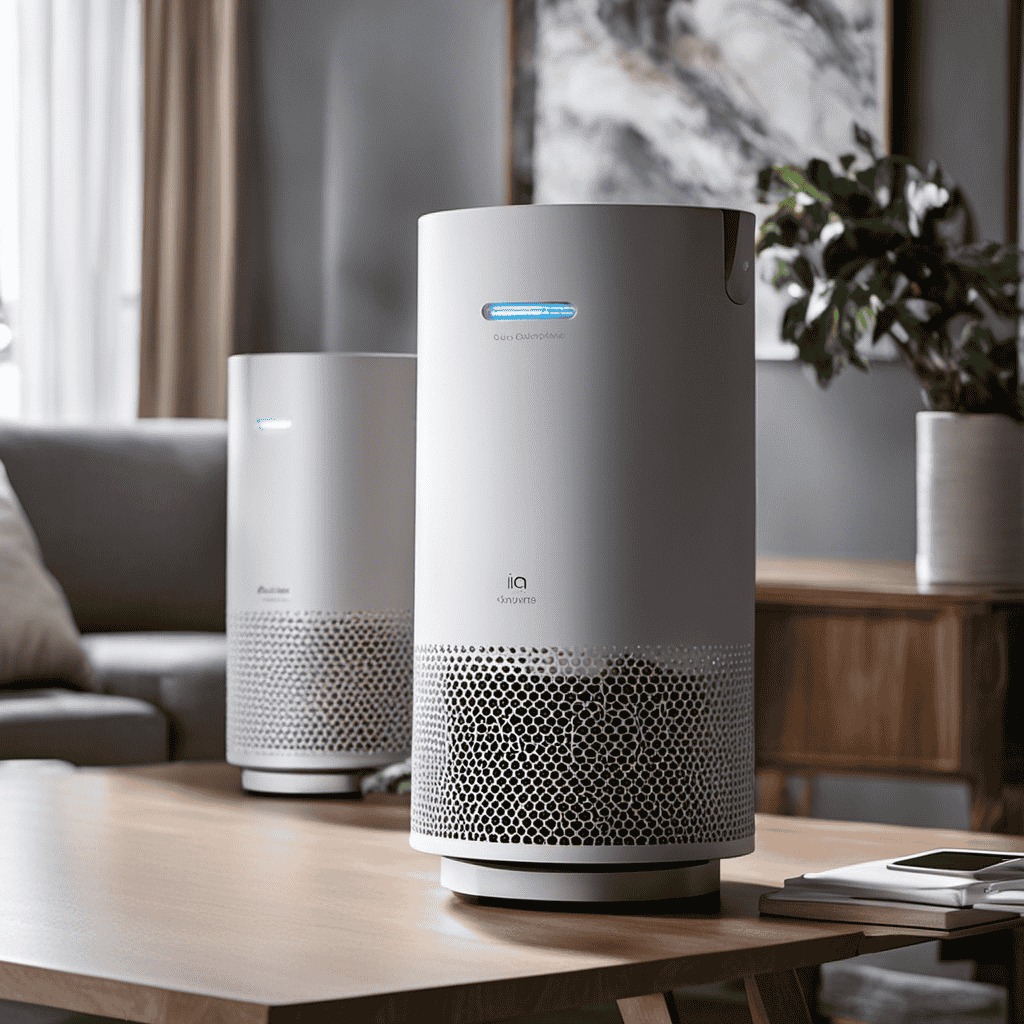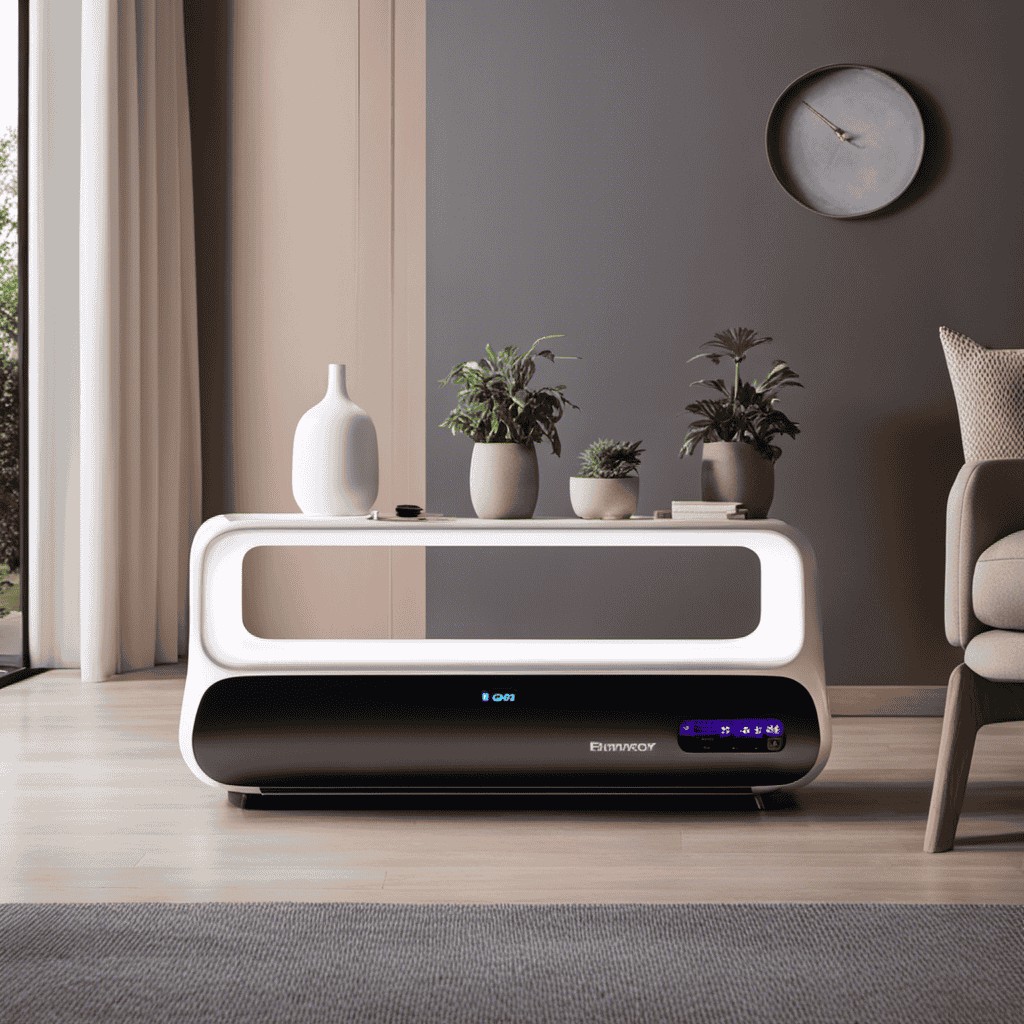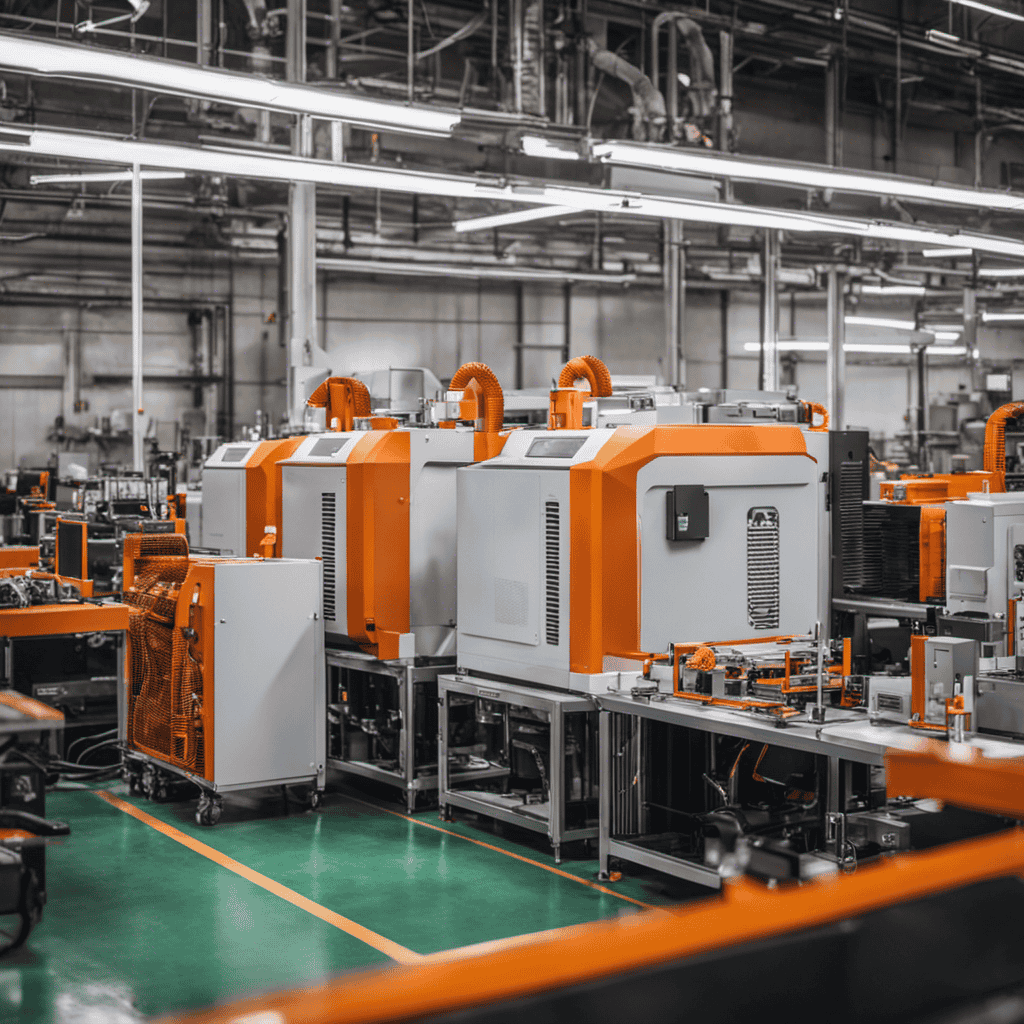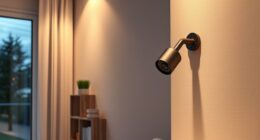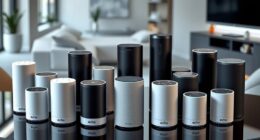Curious about the functioning of an ionic air purifier? I have the information you need!
In this article, we’ll delve into the fascinating world of ionic air purification and explore the science behind it.
We’ll uncover the role of negative and positive ions in improving air quality and discover how these purifiers can enhance the air we breathe indoors.
So, let’s dive in and unravel the mysteries of how an ionic air purifier works!
Key Takeaways
- Ionic air purifiers use electrically charged ions to remove pollutants from the air.
- Negatively charged ions attach to positively charged particles in the air, causing them to fall out of the air.
- Some ionic purifiers also produce ozone, which can neutralize pollutants.
- Ionization significantly improves indoor air quality.
The Basics of Ionic Air Purifiers
Ionic air purifiers use electrically charged ions to remove pollutants from the air. The science behind ionization is fascinating. When air passes through an ionic air purifier, it is charged with negative ions. These negatively charged ions attach themselves to positively charged particles in the air, such as dust, pollen, and bacteria. This process causes the particles to become too heavy to remain airborne, causing them to fall out of the air and onto surfaces.
Additionally, some ionic air purifiers also produce ozone, which can react with pollutants and neutralize them. The benefits of ionizing technology are numerous. It can effectively remove allergens, smoke, and odors from the air, improving indoor air quality. Furthermore, ionizing technology is often quieter and more energy-efficient compared to other air purification methods.
Understanding Ionization in Air Purification
Understanding how ionization works in an air purifier can help clarify its effectiveness.
The ionization mechanism in air purifiers involves the creation of charged particles, or ions, which interact with airborne particles, such as allergens and pollutants. These ions are typically negatively charged and attach themselves to positively charged particles in the air.
This process causes the particles to become too heavy to remain airborne and they eventually settle onto surfaces. By removing these particles from the air, ionization can significantly improve indoor air quality. This is particularly important for individuals with respiratory health issues, as airborne particles can trigger or exacerbate symptoms.
However, it is worth noting that ionization can also produce ozone as a byproduct, which can be harmful if present in high concentrations. Therefore, it is crucial to choose an air purifier with low ozone emission to minimize any potential negative impact on respiratory health.
How Negative Ions Improve Air Quality
To improve your air quality, negative ions attach themselves to airborne particles, causing them to become too heavy and settle onto surfaces. Negative ions are molecules that have gained an electron and carry a negative charge.
These ions are naturally present in the environment, especially near waterfalls, forests, and other natural settings. Research has shown that negative ions can have positive effects on mental health and overall well-being.
Negative ion generators are devices that produce a high concentration of negative ions, which can help to improve air quality indoors. The benefits of negative ion generators include reducing the levels of airborne pollutants such as dust, pollen, and mold spores.
Additionally, negative ions have been found to enhance mood, reduce stress, and improve sleep quality. Incorporating a negative ion generator into your indoor environment can provide numerous benefits for both your physical and mental health.
The Role of Positive Ions in Air Purification
If you’re looking to improve air quality, positive ions can play a role in the purification process. Positive ionization is a technique used by air ionizers to remove harmful pollutants from the air we breathe.
Air ionizers work by releasing negatively charged ions into the air, which attach themselves to positively charged particles like dust, smoke, and allergens. This process causes the particles to become too heavy to remain airborne, causing them to settle on surfaces or be easily removed through cleaning.
However, an excess of negative ions in the air can lead to an imbalance and cause respiratory issues. To counteract this, air ionizers also release positive ions that help restore the balance and neutralize the negative ions.
The Science Behind Ionic Air Purification
The ionization process in air purification is a fascinating scientific phenomenon. When air is ionized, it means that the molecules in the air gain or lose electrons, resulting in the formation of positive or negative ions.
This process is crucial in removing pollutants and allergens from the air, making it cleaner and healthier to breathe. Additionally, the benefits of ionic purification include improved indoor air quality, reduction in respiratory issues, and elimination of unpleasant odors.
Ionization Process Explained
When using an ionic air purifier, you’ll notice that the ionization process helps to remove harmful particles from the air. Negative ion generation is a key component of this process, as it involves the production of negatively charged ions that attract and neutralize airborne pollutants.
Here are some benefits of ionized air:
-
Improved air quality: Negative ions attach themselves to dust, pollen, and other allergens, causing them to drop out of the air and making it easier to breathe.
-
Odor elimination: Ionized air can help to eliminate unpleasant odors by neutralizing the molecules responsible for the smell.
-
Increased energy levels: Negative ions have been shown to increase the flow of oxygen to the brain, promoting mental clarity and overall well-being.
Overall, the ionization process in an ionic air purifier plays a crucial role in improving indoor air quality and creating a healthier environment.
Benefits of Ionic Purification
One of the benefits of ionized air is the improvement in overall well-being due to the increased flow of oxygen to the brain.
Negative ions, generated by ionic purification, have been shown to have a positive impact on respiratory health. These ions attach themselves to harmful particles in the air, such as allergens and pollutants, causing them to become heavier and fall to the ground. This reduces their presence in the air, making it cleaner and easier to breathe.
Additionally, negative ions are believed to stimulate the cilia in our respiratory system, which helps to keep our airways clear and functioning properly. This can lead to a decrease in respiratory issues such as asthma and allergies.
Ionic Air Purifiers Vs. Traditional Filters
If you’re comparing ionic air purifiers to traditional filters, you’ll find that they use different methods to clean the air. Ionic purifiers work by emitting negative ions into the air, which attach themselves to airborne particles and make them too heavy to remain suspended. This causes the particles to fall onto surfaces where they can be easily cleaned. On the other hand, HEPA filters in traditional air purifiers use a physical barrier to capture and trap particles as air passes through the filter.
Pros of Ionic Air Purification:
- Can remove particles as small as 0.01 microns
- No need to replace filters regularly
- Can neutralize odors and kill bacteria
Cons of Ionic Air Purification:
- Does not remove gases or VOCs
- Ozone emissions may be harmful in high concentrations
- Less effective in larger rooms
Overall, when choosing between ionic purifiers and HEPA filters, it’s important to consider the specific needs of your environment and the types of pollutants you want to remove.
Benefits of Using an Ionic Air Purifier
The main advantage of using an ionic purifier is that it can effectively remove particles as small as 0.01 microns. This is particularly beneficial for individuals with respiratory health issues, as these tiny particles can often cause irritation and worsen existing conditions. Ionization technology works by releasing negative ions into the air, which attach themselves to harmful particles like dust, pollen, and mold spores. These charged particles then become attracted to positively charged surfaces, such as walls or furniture, effectively removing them from the air. The table below highlights some of the key benefits of ionization technology and its impact on respiratory health:
| Benefits of Ionization Technology | Impact on Respiratory Health |
|---|---|
| Removes particles as small as 0.01 microns | Reduces respiratory irritation |
| Eliminates harmful pollutants | Improves air quality |
| Reduces allergens in the air | Alleviates symptoms of asthma |
| Helps eliminate odors | Relieves congestion |
| Silent operation | Promotes better sleep |
Common Contaminants Removed by Ionic Purifiers
Using an ionic purifier can effectively remove common contaminants from the air, such as dust, pollen, and mold spores.
Ionic purifiers work by emitting negatively charged ions into the air, which attach to positively charged particles in the air. These particles then become too heavy to remain suspended in the air and are subsequently removed from the environment.
This process, known as ionization, has been shown to have high removal efficiency for various pollutants, including those mentioned above.
By reducing the concentration of these contaminants in the air, ionic purifiers can have a positive impact on respiratory health.
The removal of dust, pollen, and mold spores can help to alleviate symptoms of allergies and asthma, improving overall indoor air quality and promoting better respiratory well-being.
How Ionic Air Purifiers Eliminate Odors
Eliminating odors is one of the key benefits that ionic purifiers offer. These devices use a unique elimination process to remove unpleasant scents from the air we breathe. The elimination process begins when the purifier releases negatively charged ions into the air. These ions attach themselves to the positively charged odor molecules present in the environment. As a result, the odor molecules become too heavy to remain airborne and eventually fall to the ground or attach to surfaces. This effectively removes the odors from the air, providing a fresher and cleaner environment. Here is a table highlighting some common odors that can be eliminated by ionic purifiers:
| Odor Type | Examples |
|---|---|
| Cooking Odors | Garlic, Onion, Fish |
| Pet Odors | Urine, Dander, Feces |
| Tobacco Odors | Cigarette Smoke, Ashtrays |
| Moldy Odors | Mildew, Dampness |
Can Ionic Air Purifiers Help With Allergies
When it comes to allergy relief, many people turn to ionizers as a potential solution. But how effective are these ionic purifiers in actually providing relief?
In this discussion, I will explore the efficacy of ionizers in alleviating allergies and whether they live up to their claims.
Allergy Relief With Ionizers
Ionizers can help provide relief from allergies by removing airborne particles and allergens from the air. This is made possible through the use of ionizer technology, which releases negatively charged ions into the air.
These ions attach themselves to positively charged particles such as dust, pollen, and pet dander, causing them to become heavy and fall to the ground. As a result, the concentration of allergens in the air is reduced, leading to reduced symptoms for allergy sufferers.
Some key benefits of using ionizers for allergy relief include:
- Effective removal of allergens from the air
- Improved indoor air quality
- Reduced allergy symptoms, such as sneezing and congestion
Efficacy of Ionic Purifiers?
The efficacy of ionic purifiers can be assessed by studying the reduction in allergy symptoms experienced by users. Ionic purifiers work by emitting negative ions into the air, which attach themselves to airborne particles, making them too heavy to remain suspended and causing them to fall to the ground or be trapped in filters.
This process helps to remove allergens such as pollen, dust mites, and pet dander from the air, reducing the likelihood of allergic reactions. However, it is important to consider the long-term effects of ionization.
Some studies suggest that high levels of negative ions in the air may have negative effects on respiratory health, while others indicate potential benefits such as improved mood and increased energy levels. More research is needed to fully understand the potential benefits and drawbacks of ionic purifiers in the long term.
The Effectiveness of Ionic Air Purifiers on Mold Spores
You’ll be interested to know that ionic air purifiers can effectively reduce the presence of mold spores in your home. These innovative devices work by emitting negatively charged ions into the air, which then attach themselves to positively charged particles, including mold spores. Once the ions and mold spores collide, they become too heavy to remain airborne and are subsequently removed from the air.
The effectiveness of ionic air purifiers on mold spores has been proven through scientific studies and testing. Here are some key benefits of using ionic air purifiers for mold spores:
- Eliminates mold spores from the air, reducing the risk of respiratory issues
- Helps prevent mold growth and the associated health hazards
- Improves overall indoor air quality, creating a healthier living environment.
Ionic air purifiers are not only effective against mold spores but also have been found to be efficient in reducing pet dander and cigarette smoke particles.
How Ionic Purifiers Improve Indoor Air Quality
Using an ionic air purifier can significantly enhance the quality of indoor air. These devices work by emitting negative ions, which attach themselves to airborne particles, causing them to become heavy and fall to the ground. This process effectively removes pollutants such as dust, pollen, and pet dander from the air, improving respiratory health and reducing allergy symptoms.
Additionally, negative ions have been found to have a positive impact on mental health. Studies have shown that exposure to negative ions can increase serotonin levels in the brain, leading to improved mood and reduced stress levels.
Furthermore, ionizers can also improve sleep quality. The release of negative ions promotes relaxation and helps to create a calm and peaceful environment, leading to a more restful night’s sleep.
Considering these benefits, it is important to carefully consider various factors when choosing an ionic air purifier that suits your needs.
Factors to Consider When Choosing an Ionic Air Purifier
When choosing an ionic air purifier, it’s important to consider factors such as room size, filter replacement cost, and noise level. These factors can greatly impact the effectiveness and convenience of the purifier in your home or office.
-
Room Size: Consider the square footage of the area you want to purify. Different models have different coverage capacities, and choosing the right size will ensure optimal air purification.
-
Filter Replacement Cost: Ionic air purifiers typically require regular filter replacements. It’s crucial to factor in the cost of these replacements to ensure that the purifier remains cost-effective in the long run.
-
Noise Level: Some ionic purifiers can be noisy, especially at higher fan speeds. If noise is a concern for you, look for models that offer quieter operation without compromising on air purifying capabilities.
Considering these important features will help you make an informed decision and find the most suitable ionic air purifier for your needs.
The Maintenance and Care of Ionic Air Purifiers
To keep your ionic air purifier running smoothly, it’s essential to regularly clean the collection plates and replace the filters as needed. Proper care and cleaning of your air purifier will ensure optimal performance and maintain air quality in your space. Cleaning the collection plates should be done at least once a month, or more frequently if you notice a buildup of particles. Simply remove the plates and wash them with warm soapy water, then dry them thoroughly before reinserting. As for filter replacement, it is recommended to follow the manufacturer’s instructions as different models have varying lifespans for their filters. Refer to the table below for general guidelines on filter replacement frequency based on usage:
| Usage Level | Filter Replacement Frequency |
|---|---|
| Low | Every 3-6 months |
| Moderate | Every 2-4 months |
| High | Every 1-2 months |
Safety Precautions and Considerations for Ionic Air Purifiers
As an expert in air purification systems, I would like to discuss some important maintenance tips for ionic air purifiers and address common health concerns associated with ionizers.
First, it is crucial to regularly clean the collection plates of the ionic air purifier to ensure optimal performance. Proper maintenance of the collection plates helps to remove any buildup of dust, dirt, or other particles that can hinder the purifier’s effectiveness.
Additionally, proper placement of the device is important. It should be positioned away from direct airflow, such as vents or windows, to prevent interference with the purifier’s operation. This allows the device to effectively circulate and purify the air in the room.
Regular filter replacement is also essential for maintaining the effectiveness of the air purifier. Filters can become clogged with particles over time, reducing their ability to capture pollutants. Following the manufacturer’s recommendations for filter replacement ensures that the purifier continues to work efficiently.
Now, let’s address common health concerns related to ionizers. One concern is the production of ozone. Some ionizers generate ozone as a byproduct, which can be harmful to individuals with respiratory conditions. It is important to choose an ionizer that produces minimal ozone or to use it in a well-ventilated area.
Another concern is potential respiratory irritation. Some people may experience irritation or discomfort when exposed to ionizers. This can be due to the charged particles in the air or the release of volatile organic compounds (VOCs). If you experience any discomfort, it is recommended to limit exposure or consider alternative air purification methods.
Maintenance Tips for Ionic Air Purifiers
Make sure you clean the collection plates regularly to ensure optimal performance of your ionic air purifier. The collection plates in an ionic air purifier are responsible for attracting and capturing airborne particles such as dust, pollen, and pet dander. Neglecting to clean these plates can lead to reduced efficiency and a decrease in air purification effectiveness.
To maintain your ionic air purifier, follow these maintenance tips:
- Remove the collection plates from the purifier according to the manufacturer’s instructions.
- Use a soft brush or cloth to gently wipe away the accumulated particles from the plates.
- Rinse the plates with water to remove any remaining residue.
Regular cleaning of the collection plates will help to prevent clogging and ensure that your ionic air purifier continues to effectively remove airborne pollutants, providing you with clean and fresh air.
Common Health Concerns With Ionizers
Ensure that you are aware of common health concerns associated with ionizers before using them in your home. While air purifiers have numerous benefits, it is important to consider the safety of ionizers.
One major concern is the production of ozone. Ionizers work by emitting negatively charged ions into the air, which can react with oxygen molecules to create ozone. High levels of ozone can irritate the respiratory system and exacerbate conditions such as asthma.
Additionally, some ionizers may release harmful byproducts into the air, such as formaldehyde or volatile organic compounds (VOCs). It is crucial to choose an ionizer that meets safety standards and has been tested for ozone emissions.
Regular maintenance, such as cleaning the ionizer plates, can also help minimize potential health risks.
Frequently Asked Questions
Are There Any Potential Health Risks Associated With Using an Ionic Air Purifier?
I’m not sure about the potential health risks of using an ionic air purifier. I would need to compare its effectiveness to other types of air purifiers and consult scientific studies to provide a more informed answer.
Can Ionic Air Purifiers Remove Pet Dander and Pet Hair From the Air?
Ionic air purifiers are like miniature superheroes, using charged ions to attract and capture pet dander and hair from the air. This not only benefits asthma sufferers but also helps in choosing the right size for your home.
How Often Do the Filters in an Ionic Air Purifier Need to Be Replaced?
The cost of replacement filters for an ionic air purifier depends on the brand and model. To maximize the lifespan of the filters, regular maintenance is essential. Cleaning the filters every 2-4 weeks can help prolong their effectiveness.
Do Ionic Air Purifiers Generate Ozone?
Yes, ionic air purifiers do generate ozone. They work by releasing negatively charged ions into the air, which attach to particles and make them fall out of the air. However, this process also produces ozone as a byproduct.
Can an Ionic Air Purifier Eliminate Cigarette Smoke and Its Smell From the Air?
Yes, an ionic air purifier can efficiently eliminate cigarette smoke and its smell from the air. It uses negatively charged ions to attract and neutralize the positively charged smoke particles, providing clean and fresh air.
What Are the Benefits of Using an Ionic Air Purifier?
The ionic air purifier operation explained is a method of air purification that uses negatively charged ions to remove airborne contaminants. Using this type of air purifier can result in improved air quality, reduced odors, and fewer harmful particles in the air. Additionally, it can help alleviate allergies and respiratory issues.
Conclusion
In conclusion, I am astounded by the ability of an ionic air purifier to transform the air we breathe. Like miniature superheroes, these purifiers release negative ions that attract and neutralize harmful pollutants, leaving behind only fresh, clean air.
The science behind the process is fascinating. Positive ions also play a crucial role in purifying the air. By understanding the science and factors to consider, we can make informed choices to improve indoor air quality.
So let’s embrace the power of ionic air purifiers and breathe in the refreshing embrace of purified air.
